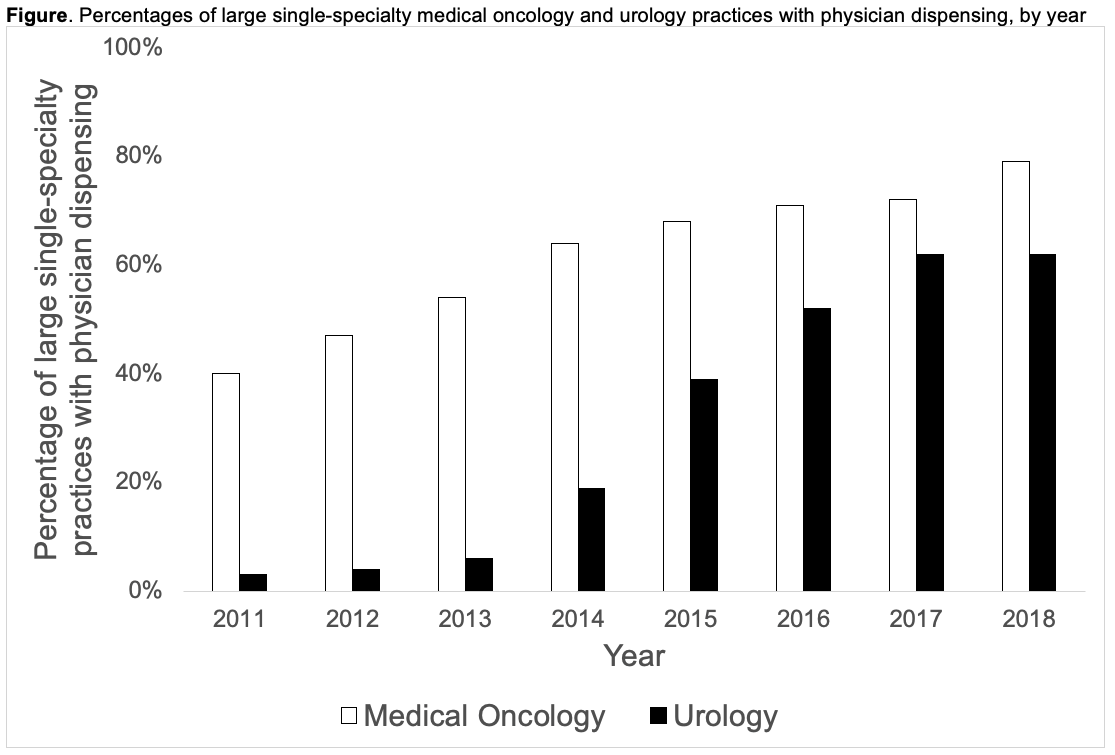Back
Poster, Podium & Video Sessions
Moderated Poster
MP28: Health Services Research: Practice Patterns, Quality of Life and Shared Decision Making III
MP28-12: Proliferation of physician dispensing among large single-specialty medical oncology and urology practices
Saturday, May 14, 2022
1:00 PM – 2:15 PM
Location: Room 228
Lillian Lai*, Samuel Kaufman, Mary Oerline, Megan Caram, Avinash Maganty, Chad Ellimoottil, Vahakn Shahinian, Brent Hollenbeck, Ann Arbor, MI

Lillian Y. Lai, MD,MS
University of Michigan
Poster Presenter(s)
Introduction: With the availability of oral targeted therapies, such as abiraterone since 2011 and enzalutamide since 2012, men with advanced prostate cancer can receive cancer treatment at home. By 2015, these oral therapies replaced docetaxel, an intravenous chemotherapy, as the most common first-line treatment for advanced prostate cancer. Prescriptions for oral therapies can be dispensed on-site or through a pharmacy owned by the practice of the physician (collectively referred to as physician dispensing). As a first step towards understanding physician dispensing in the context of increasing use of oral targeted therapies, we described the proliferation of physician dispensing among large single-specialty medical oncology and urology practices from 2011 to 2018.
Methods: Men with advanced prostate cancer were identified in a 20% sample of national Medicare claims. The predominate managing physician was identified and associated with a practice using the Medicare Data on Provider Practice and Specialty file. Physician dispensing was identified using data from the National Council for Prescription Drug Program, which included the inception date of the pharmacy or the non-pharmacy dispensing site. Large single-specialty medical oncology and urology practices were defined as practices with =10 medical oncologists (or urologists, respectively) in which =50% of the physicians were medical oncologists (or urologists, respectively). This analysis focused on practices present throughout all 8 years of the study.
Results: From 2011 to 2018, the percentage of large single-specialty medical oncology practices with physician dispensing grew from 40% to 79%. Over the same eight-year period, the percentage of large single-specialty urology practices with physician dispensing grew from 3% to 62%. The largest increase occurred from 2014 to 2015, with an additional 20% of large single-specialty urology practices offering physician dispensing, which coincided with when enzalutamide was approved for use in the pre-chemotherapy setting.
Conclusions: Physician dispensing is increasingly common. The streamlined model, coupled with the longstanding patient-physician relationship, has the potential to reduce care fragmentation and improve access.
Source of Funding: AHRQ R01 HS025707; VBS,BKH; NCI T32 CA180984; LYL, AM

Methods: Men with advanced prostate cancer were identified in a 20% sample of national Medicare claims. The predominate managing physician was identified and associated with a practice using the Medicare Data on Provider Practice and Specialty file. Physician dispensing was identified using data from the National Council for Prescription Drug Program, which included the inception date of the pharmacy or the non-pharmacy dispensing site. Large single-specialty medical oncology and urology practices were defined as practices with =10 medical oncologists (or urologists, respectively) in which =50% of the physicians were medical oncologists (or urologists, respectively). This analysis focused on practices present throughout all 8 years of the study.
Results: From 2011 to 2018, the percentage of large single-specialty medical oncology practices with physician dispensing grew from 40% to 79%. Over the same eight-year period, the percentage of large single-specialty urology practices with physician dispensing grew from 3% to 62%. The largest increase occurred from 2014 to 2015, with an additional 20% of large single-specialty urology practices offering physician dispensing, which coincided with when enzalutamide was approved for use in the pre-chemotherapy setting.
Conclusions: Physician dispensing is increasingly common. The streamlined model, coupled with the longstanding patient-physician relationship, has the potential to reduce care fragmentation and improve access.
Source of Funding: AHRQ R01 HS025707; VBS,BKH; NCI T32 CA180984; LYL, AM


.jpg)
.jpg)